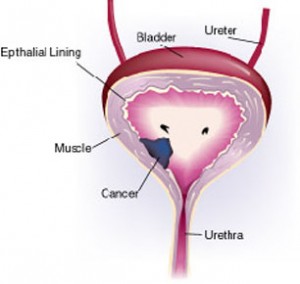 Bladder cancer is the growth of cells that cannot be controlled in the urinary bladder which are not like the normal mechanism of a human body. Bladder cancer can spread to other body parts including the lungs, bones, and liver.
Bladder cancer is the growth of cells that cannot be controlled in the urinary bladder which are not like the normal mechanism of a human body. Bladder cancer can spread to other body parts including the lungs, bones, and liver.
It actually starts from the innermost layer of the bladder and then spreads to the deeper layers while it grows. It may appear in various forms; with the most common appearance is shrub-like.
Bladder cancer is divided on the basis of the appearance of its cells when seen with a microscope. Bladder cancer has many types which may lead to complications in selecting the appropriate treatment. For example, some types do not respond to radiation and chemotherapy.
According to the National Cancer Institute, it is the seventh most common cancer in the UK, where approximately 10,000 diagnoses are made each year.
Smoking is the main reason responsible for bladder cancer. The National Health Service (NHS), United Kingdom, estimates that smoking causes 50%-60% of male bladder cancers and 20%-30% of female bladder cancers.
There are many types of bladder cancer. They are:
- Urothelial carcinoma also known as “transitional cell carcinoma” is the most common type. It is strongly due to smoking.
- Aden carcinoma of the bladder is due to inflammation and irritation.
- Squalors cell carcinoma is also associated with prolonged infection, inflammation, and irritation such as that associated with longstanding stones in the bladder.
Multiple tumors, large tumors and returning despite treatment with BCG are also at higher risk of recurrence and decrease the time progression. The and grade, better. Typically these tumors, even when race, do the same grade point than the original tumor and not to endanger the life expectancy patient. These tumors should be managed and controlled more aggressively as they have the potential to invade and spread to other body parts that shortens life expectancy patient. Other of factors such as number, size, pattern of response to initial treatment and recurrence of certain genetic mutations play a role.
This requires regular monitoring, even in these low-risk tumors. They are also much more likely to invade deeper layers with growth rates of 17% -45% of tumors years. These one and five years have a higher recurrence in the range of 61% -78% at five years and low risk superficial bladder cancer respectively. For, the chances of recurrence are about 15% in one year and 32% in five years after initial diagnosis. However, unlike the more aggressive variant of bladder cancer, the chances of progression (eg, the chances that the tumor invades the deeper layers of the bladder) are less than 1%. High-risk superficial tumors are those that are high quality T1 tumors and / or are associated with large areas of carcinoma in situ.There are some of the important factors that influence the healing of the bladder cancer stage and tumor grade.
No Comments Yet